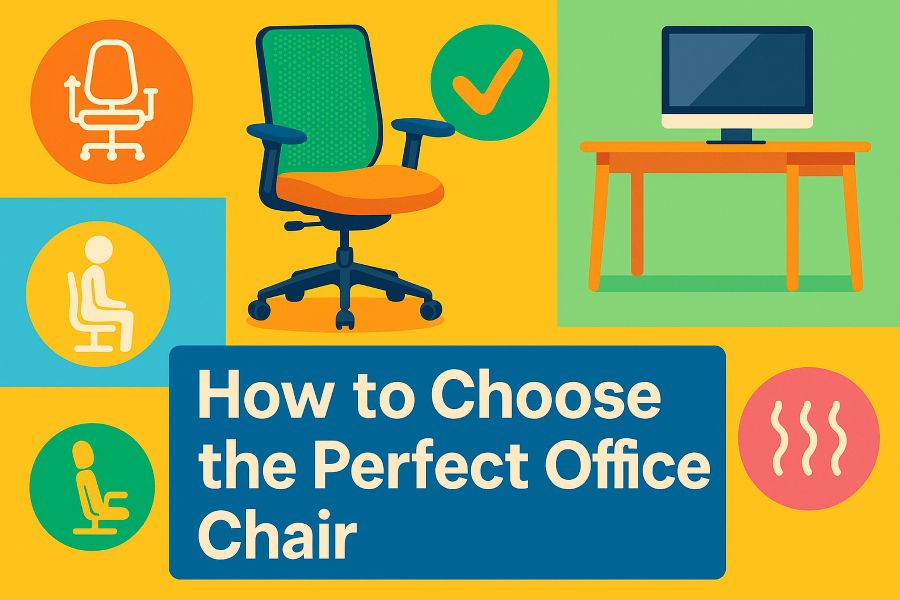How to Choose the Perfect Office Chair and Desk Setup for Your Home Office

With remote and hybrid work now a permanent feature of professional life across the UK, the makeshift dining table setup is no longer a viable long-term solution. A proper home office is essential, and at its heart are two key components: the office chair and the office desk. Investing in the right pairing isn’t just about comfort; it’s a crucial step towards protecting your health, preventing long-term strain, and boosting your daily productivity. A well-designed workspace can transform your work-from-home experience from a daily grind into a seamless, focused, and enjoyable part of your routine. This guide will walk you through everything you need to know to choose the perfect setup for your needs, space, and budget.
The Importance of Ergonomics
The term “ergonomics” simply means designing things to be efficient and comfortable for people to use. When it comes to your home office, ergonomic furniture is designed to support your body’s natural posture, reducing stress on your spine, neck, and shoulders. A poor setup often leads to persistent back pain, neck ache, and repetitive strain injury (RSI). Over time, these issues can seriously impact your wellbeing and ability to concentrate.
To avoid this, look for key ergonomic features. For an office chair, this includes adjustable lumbar support to cushion your lower back, customisable seat height and depth, and supportive armrests. For an office desk, the primary considerations are correct height (your elbows should be at a 90-degree angle when typing), sufficient legroom to allow movement, and a large enough surface area for all your equipment without feeling cluttered.
Choosing the Right Office Chair
Your office chair is arguably the most important piece of furniture in your workspace. You’ll be spending hours in it, so it needs to be supportive, comfortable, and tailored to you.
Key Features to Look For:
- Adjustability: Look for a chair with adjustable seat height, back tilt, and tilt tension. This allows you to position yourself correctly relative to your desk and find a comfortable recline.
- Lumbar and Armrest Support: Good lumbar support maintains the natural curve of your spine. Adjustable armrests help take the strain off your shoulders and neck, but make sure they can be positioned to fit under your desk.
- Breathable Materials: A mesh back offers excellent ventilation, which is ideal for long work sessions. Fabric is also a popular, comfortable choice, while leather offers a premium look but can be less breathable.
- Style and Fit: Your office chair should complement your home’s interior. Thankfully, modern designs offer ergonomic benefits without looking overly corporate.
Types of Office Chairs:
- Ergonomic Chairs: Specifically designed for maximum support and adjustability. They are the best choice for anyone working full-time from home.
- Task Chairs: A more basic, often more compact option suitable for shorter periods of use. They are generally more affordable but offer fewer adjustable features.
- Executive Chairs: Typically larger, with high backs and plush padding. They prioritise comfort and style but may lack the fine-tuned ergonomic adjustments of dedicated models.
- Kneeling Chairs: These promote an upright posture by distributing your weight between your shins and buttocks. They can be great for posture but may take some getting used to.
For budget-conscious buyers, a good ergonomic task chair can be found for a reasonable price. If you’re investing for the long term, a premium, fully adjustable ergonomic chair is an excellent investment in your health.
Selecting the Ideal Office Desk
The right office desk provides a stable and spacious foundation for your work. Your choice will depend on your available space, work style, and ergonomic needs.
How to Choose:
- Measure Your Space: Before you start shopping, measure the area where the desk will go. Remember to account for the space needed for your chair and for you to move around comfortably.
- Consider Your Work Style: Do you use multiple monitors? Do you need space for physical documents? A larger surface may be necessary. If you prefer to change your posture throughout the day, a standing desk is an excellent option.
- Cable Management: Look for desks with built-in cable management features like grommets or trays. This helps keep your workspace tidy and free from tangled wires, creating a more organised and less distracting environment.
Types of Office Desks:
- Fixed Desks: The traditional choice, offering a simple and sturdy work surface.
- Standing Desks: Height-adjustable desks that allow you to alternate between sitting and standing, which is proven to be beneficial for health.
- Corner Desks: A great solution for maximising surface area in a smaller room or awkward corner.
- Compact & Folding Desks: Perfect for small flats or multi-use rooms where the workspace needs to be packed away at the end of the day.
Materials range from classic wood and durable laminate to modern glass and metal. Choose an aesthetic that blends with your home décor to ensure your workspace feels like a natural part of your living environment.
Creating a Balanced Home Office Setup
With your office chair and desk chosen, the final step is to bring them together into a functional and inspiring workspace. Proper arrangement is key to unlocking their full ergonomic potential.
Position your desk to take advantage of natural light without causing glare on your screen. The top of your monitor should be at or slightly below eye level to prevent neck strain. A monitor stand or even a stack of books can help you achieve the correct height. Ensure there’s a gap of a few inches between the front of your chair’s seat and the back of your knees.
Simple accessories can significantly enhance comfort. A footrest can provide support if your feet don’t rest flat on the floor, while a good keyboard and mouse reduce wrist strain. Don’t forget to personalise your space! Add a plant, a few photos, or some nice stationery. A tidy, organised, and pleasant workspace will not only boost your mood but also your focus and efficiency.
Conclusion
Creating a comfortable and ergonomic home office isn’t a luxury—it’s an investment in your physical wellbeing and professional productivity. By carefully selecting an office chair and office desk that support your body and fit your space, you lay the foundation for a healthier and more effective working day. A workspace that you enjoy being in encourages focus and creativity, transforming your home office from a simple necessity into a personal hub of achievement. Take the time to build a setup that works for you; your back, neck, and mind will thank you for it.



